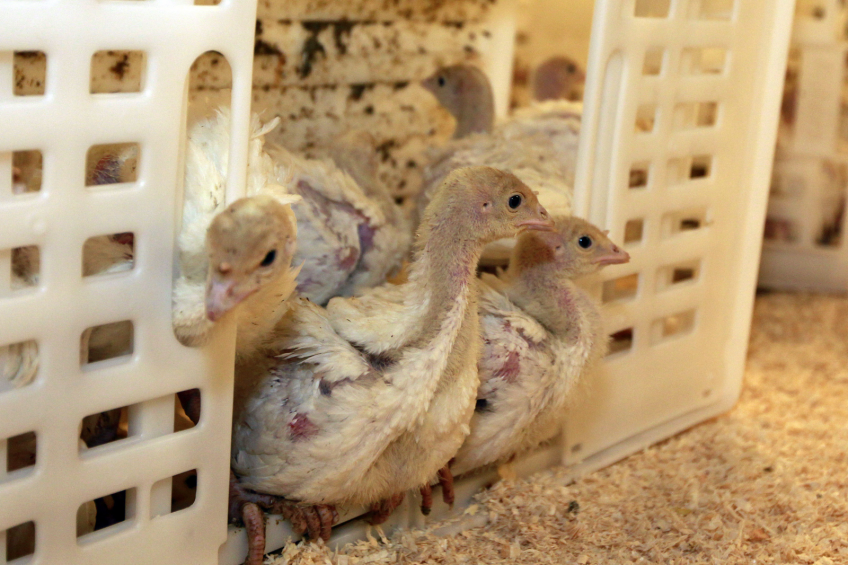Histomoniasis in poultry: New solutions needed

Following on from the ban of antibiotic use in the animal feed industry by the European Union in the early 2000s and the recent removal of the arsenical drug Histostat Nitarsone from the US market by the Federal Drug Administration (FDA), the need for novel control strategies against disease is evident. Since the removal of Histostat in late 2015, US poultry producers are seeing an increase in flock mortality due to Histomoniasis.
Histomoniasis is caused by a parasitic infection of a protozoan, Histomonas meleagridis, which can exist in flagellated and amoeboid forms. After the protozoan is ingested, it first infects the caeca, migrates through the blood stream to the liver and can then be passed out in the droppings or excreted also within the eggs of the caecal worm Heterakis gallinae, if present in the bird.
Most infections are caused by birds ingesting infected caecal worm eggs and sometimes directly by contact with infected birds where outbreaks spread quickly through flocks. The protozoa are very resistant when inside worm eggs or larvae and can be propagated from flock to flock in this way.
To date 3 different approaches have been used to combat this disease:
- application of new antibiotics with specific activity against the protozoan parasite,
- a combination of plant extracts, essential oils and organic minerals and
- the development of a vaccine.
Opposition to antibiotic use options
From both a legislative and a consumer perspective there is opposition to the use of antibiotic options, and of course the risk of protozoa developing resistance to antibiotic treatments. The use of essential oils (e.g., Oregano) in combating this disease is complicated by issues of efficacy and resistance. Vaccine development and approval has been slow due to the ubiquitous use of antibiotics in the past. Researchers are developing vaccines, using histomoniasis causing parasites, which have been rendered less virulent in the laboratory. This work is still at the development stage and additional work is required on the production of vaccines. A number of large-scale trials are currently underway but it will be months before a solution is found.
Available alternatives for treating Histomoniasis
With the removal of Histostat (Nitarsone) from the market, poultry producers have now turned towards a combination of feed ingredient strategies to combat blackhead disease. The adopted strategies form a part of a holistic feeding programme and can include a combination of feed additives, acting to limit protozoal growth.
One promising area is that of yeast mannan rich fractions (MRF) due to their ability to increase the concentration of fibroblasts, facilitating lesion healing. Also, feed additives in the form of organically bound minerals, particularly zinc and selenium-yeast, can also aid in tissue repair and increase intestinal immunoglobulins. Plant extracts such as yucca have also shown clear antiprotozoal effects in trials although high doses can be expensive.
Patented combinations, such as Natustat (Alltech Inc.), have been developed by combining several approaches rather than relying upon a single ingredient. Trials carried out in challenged broilers and turkeys have shown promise through improvements in gut health and a positive effect on body weight, when compared to non-supplemented challenged birds.
Search for new drugs
The successful search for new drugs or substances to protect birds against histomoniasis is hampered by the restrictive regulation of licensing new products for food producing animals. With more activist consumers, non-drug treatments or vaccines will be essential to ensure a sustainable poultry industry.
In response to consumer concerns, the FDA conducted a study to determine whether arsenic-based drugs used in the poultry industry resulted in higher levels of arsenic entering the food chain. Histostat (Nitarsone) was the only arsenic-based animal drug approved in the US for use in food animals. Nitarsone was approved for the prevention of blackhead disease (histomoniasis) in turkeys and chickens, but it was predominantly used in turkey production.
A recent FDA study revealed that in the 100 boiler chickens that were assessed, arsenic was detected at higher levels in the livers of chickens treated with the Histostat Nitarsone, compared with untreated chickens. Of those 100 broilers assessed, 70% tested positive for arsenic. Another study carried out at John Hopkins University also showed strong evidence that the use of arsenic-based drugs contributes to dietary arsenic exposure in consumers of conventionally produced chickens. Their findings suggested that eliminating the use of arsenic-based drugs in food animal production could reduce the burden of arsenic-related disease in the US population, as arsenic has been clinically proven to be extremely toxic to human health. Although independent scientists, poultry industry experts and representatives of the pharmaceutical industry have raised doubts about the validity of these studies, it has led to the current withdrawals.
Histomoniasis hits hard at commercial flocks
Histomoniasis was first identified in turkeys as far back as 1893. To date, this disease is still proving problematic for the poultry industry as it continues to cause sporadic but severe disease losses in commercial turkey flocks and chickens. In turkeys, most infections are fatal and can represent between an 80-100% mortality rate, whereas in other fowl susceptibility varies between species and breeds; however, in chickens, broiler breeder pullets may only suffer 10% mortality, extensive culling losses and poor uniformity at time of lay.
If the future of blackhead control is no longer based upon the availability of effective treatments such as Histostat then alternative feed based ingredients, used in combinations and not alone, combined with new vaccine options, are likely to be applied to ensure the long-term viability of the poultry industry globally.













